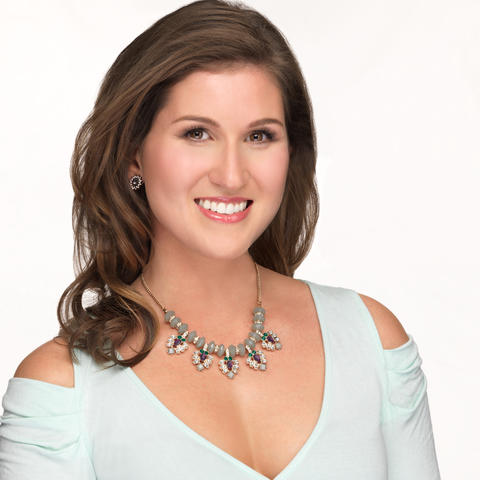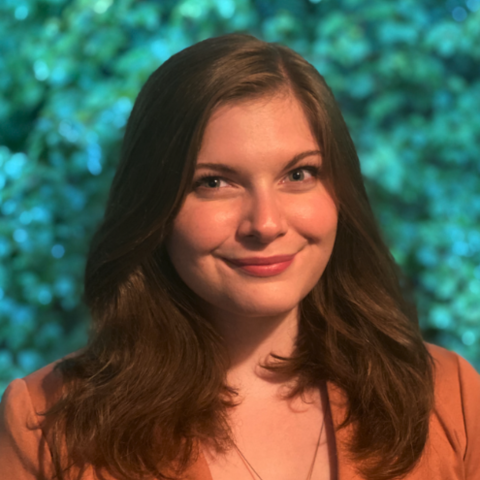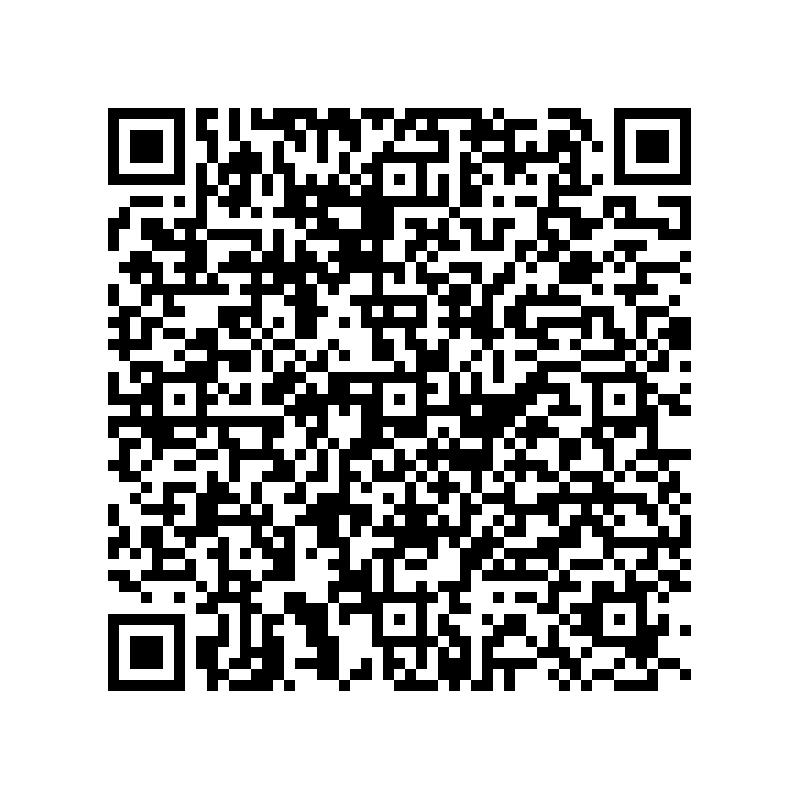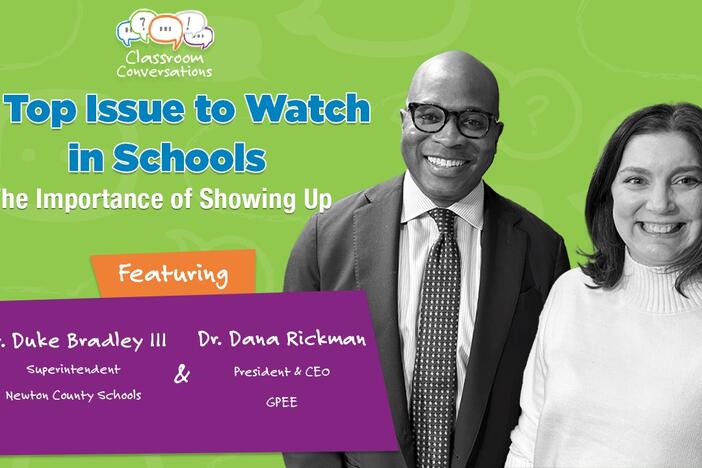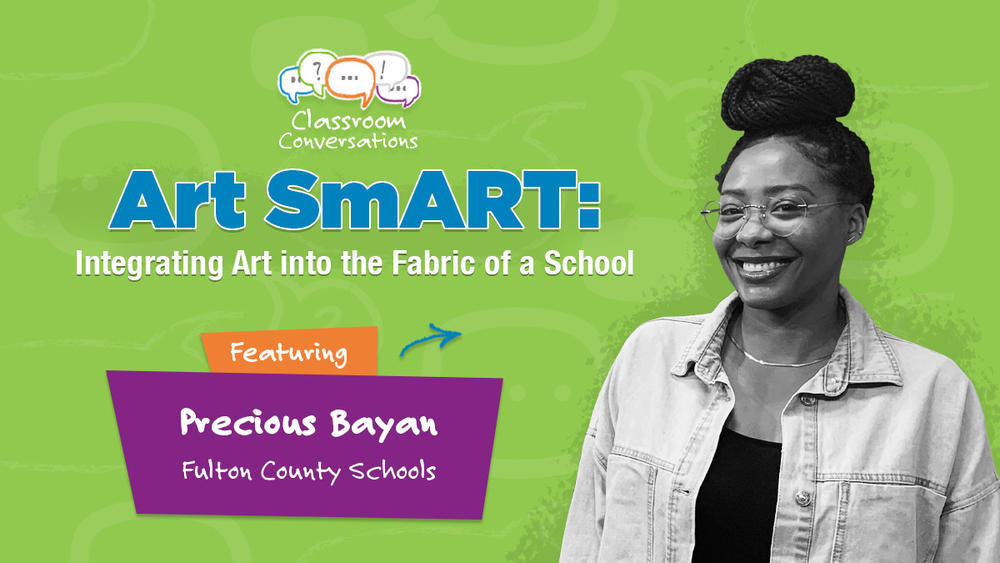
Section Branding
Header Content
Episode 209: Art SmART: Integrating Art Into The Fabric Of A School
Primary Content
Precious Bayan, art teacher at Brookview Elementary School and Fulton County Teacher of the Year, talks to us about getting students excited about learning with arts integration.

Precious Bayan, art teacher at Brookview Elementary School and Fulton County Teacher of the Year, talks to us about getting students excited about learning with arts integration.
TRANSCRIPT
Ashley Mengwasser: Hello, teachers. Welcome back to Classroom Conversations, the podcast for Georgia's teachers. Presented in partnership by the Georgia Department of Education and Georgia Public Broadcasting. I'm your host, Ashley Mengwasser. On this platform, we are committed to exploring all manner of effective approaches to learning. And today, we are integrating the arts. Hacha, what does that even mean? You don't have to be an artist the likes of which the ceiling of the Sistine Chapel has seen. Arts integration simply occurs when general education teachers incorporate an art form into their classrooms and teach the art standards and the other subject area standards at the same level of fidelity. Art can be an equal partner in the vehicle by which students learn a subject area, then demonstrate their understanding through art. We wanted a real visual arts crusader for this episode, folks. And let me tell you, our friends at DOE found her. By the end of this conversation and your own foray into arts integration, art won't be something students merely try, art will be part of who they are. Because you can't spell smart without art. It's the truth. It's basic spelling. You also can't spell martini without art either. If you ever had a bad one, you know that that's an art form. Allow me to introduce everyone, Precious Bayan, art teacher at Brookview Elementary School in Fulton County. And allow me to properly art-iculate her prestige. Precious is the 2022 Fulton County Teacher of the Year. Hey, Precious.
Precious Bayan: Hey.
Ashley Mengwasser: A real life celeb before us. You giggle, but I mean it.
Precious Bayan: Oh man. I'm still not used to celebrity status.
Ashley Mengwasser: Well, get used to it. How long have you been teaching, Precious?
Precious Bayan: I kind of started halfway through a year, so it gets kind of confusing to me. And once you've been there for so long, the years just start to rack up. But I think starting this year it'll be about 13 or 13 and a half years.
Ashley Mengwasser: All right. Your career is a teenager. Congratulations. Why did you decide to become a teacher? Do you remember?
Precious Bayan: I’ve always had a love of learning, which I think a lot of teachers have, and a lot of teachers also have that little bossy nature about us.
Ashley Mengwasser: Okay.
Precious Bayan: So, combining the two, being bossy and liking to learn, hey, it's the perfect makings for a teacher.
Ashley Mengwasser: Here you are. But you were getting a degree in something else.
Precious Bayan: Oh yeah. So I, now mind you, I probably was born a teacher. All my life I've been hearing, "You're a teacher, you're a teacher." But I try to get as far away from that as possible. I did not want to deal with the kids and all this other stuff.
Precious Bayan: So, I got my undergrad degree in fashion merchandising and graphic design. And then I realized that the merchandising part, I had this picture in my head of going to different countries and picking out things that goes in stores and all that cool stuff. And I realized most of the time you walk into a room with gray walls and they say, "We have this yellow shirt, how many do you want in your store?"
Precious Bayan: And then I loved graphic design. I still do, but just the constant staring at computers all day, I needed to interact with people and just share what I love. So the day after I graduated from Clark Atlanta with my degree, the very next day I was enrolling in Georgia State to get certified in education.
Ashley Mengwasser: Look at that.
Precious Bayan: I couldn't run away from it.
Ashley Mengwasser: Couldn’t resist the path. But fashion merchandising and graphic design, those could be easily parlayed into what you do.
Precious Bayan: Oh yeah, most definitely.
Ashley Mengwasser: Yeah.
Precious Bayan: I put a little bit of me in everything I do, so it's...
Ashley Mengwasser: Spoken like a true artist.
Precious Bayan: It’s putting a little bit of that into the classroom. I would say it's pretty much the same, you just get to teach people about it. I can teach kids about graphic design. Or if they're into fashion, we can have a lesson about that as well.
Ashley Mengwasser: Yeah. And those wild kids you were trying to avoid are now the very thing you needed that you weren't going to get in fashion merchandising.
Precious Bayan: Yes.
Ashley Mengwasser: No day is boring.
Precious Bayan: And they're still wild, but no day is boring.
Ashley Mengwasser: Respect that. Okay. Well, let's talk about this. I just want to go through some skills, see if you do any of these. Do you draw?
Precious Bayan: I draw yes, a little bit. I'm not the best drawer, but I do draw, yes. If I could see it, I can draw it. But I can't draw it out my head like illustrators. That still amazes me.
Ashley Mengwasser: Yeah, that's something else. Do you paint?
Precious Bayan: I do paint. I love painting. That's actually what I got my education degree concentration in, was painting.
Ashley Mengwasser: Do you sing?
Precious Bayan: In the shower.
Ashley Mengwasser: Hey.
Precious Bayan: I am Beyonce in the shower.
Ashley Mengwasser: That counts.
Precious Bayan: And you can't tell me differently.
Ashley Mengwasser: I’m with you on that. Do you sculpt?
Precious Bayan: Sculpting. I love teaching clay, but I'm not a sculptor. What sculptors do are also amazing to me to take this block of marble or clay or whatever it is, and you can carve at it and carve at it. And the thing that frightens me is that if you make a mistake, you can't put it back, it's there. So I like to be able to erase. But clay is one of my favorite things to teach kids. It's a great time. It's wild.
Ashley Mengwasser: Well, the movie Ghost taught me that sculpting can be a good time. Why art for you overall? What's your passion for art?
Precious Bayan: I think art is less about, it's what I do versus who I am. I was born an artist. I always loved drawing and I love color. I could literally spend 30 minutes trying to figure out what's the difference between a lime green and a chartreuse green and any other green. So it's hard to explain when you're just born that way. But if I was going to teach any subject and it's who I am, why not it be art?
Ashley Mengwasser: Why not art? What is the benefit of art to the kids in your experience?
Precious Bayan: The benefit of art, and that's all arts, whether it's visual arts or music, any art, it really engages kids in something that's so, what I believe, is natural to human beings. Every kid is born wanting to play, they love drawing, they love singing, they love coloring. So if I can put that natural love of the arts that every human is born with into them learning about math, science, or social studies, it's a win-win situation.
Ashley Mengwasser: And you're doing it. Who are your favorite artists personally? Who do you like to follow?
Precious Bayan: Lately I've been following Kehinde Wiley. He's the guy that did the Barack Obama portrait.
Ashley Mengwasser: Oh, that portrait's amazing.
Precious Bayan: I love his use of color. Of course, I'm a color girl.
Ashley Mengwasser: Color girl.
Precious Bayan: And pattern. And I love how some artists can just use color to make it really seem like light is shining on skin. It's amazing to me. And then my favorite overall is Mark Rothko.
Ashley Mengwasser: Mark Rothko.
Precious Bayan: And of course, he just paints with color. That's it. You look at the canvas, it's full of color. But he evokes so much emotion in his paintings and it's just beautiful to me. Yeah.
Ashley Mengwasser: Looking at his work, it is astoundingly simple, yet it is evocative.
Precious Bayan: It is. It is.
Ashley Mengwasser: You’re right. I feel like this would be a good artist for teachers to show their students and say, "What does this make you feel?" Because it literally is just blocks of color. Of course, you like it knowing what I know about you.
Precious Bayan: Oh yes. And I do that with my kids as well.
Ashley Mengwasser: Yes.
Precious Bayan: Yes.
Ashley Mengwasser: Ooh, that sounds like fun to be a fly on the wall for that. Okay. Well, I know you like color because you told me. I bet you haven't done this before, it's the one thing that I can bring to the table that's original in this conversation. I'm not an arts and crafts girl, but you're going to like this.
Precious Bayan: Okay.
Ashley Mengwasser: Have you heard of colorstrology?
Precious Bayan: No. Tell me more about it.
Ashley Mengwasser: Okay. Well, I'm sort of into the woo woo things and there's this book I got at this great bookstore. It's about colorstrology. And it tells you your personal color based on your birthdate and your astrology. And so I'm dying to know what color you are. Would you tell me your birthday?
Precious Bayan: My birthday is October 24th. I'm a Scorpio. Do I have to give you the year?
Ashley Mengwasser: No. No.
Precious Bayan: Okay. Okay.
Ashley Mengwasser: No. That's your secret's safe without us.
Precious Bayan: I need this book in my life.
Ashley Mengwasser: I know.
Precious Bayan: Oh my goodness.
Ashley Mengwasser: Isn’t it pretty? And has all these colors and stuff.
Precious Bayan: It’s so pretty.
Ashley Mengwasser: Do you want to guess generally what color you are?
Precious Bayan: I would say... Well, I don't know if I should guess my color versus my favorite colors.
Ashley Mengwasser: Oh.
Precious Bayan: My favorite color, surprisingly is black.
Ashley Mengwasser: The absence of white.
Precious Bayan: It’s a basic color that goes with everything. I love black. But if I had to guess a color for me, it would be like a merry-gold yellowish orange-ish color.
Ashley Mengwasser: Yellowy? It's not yellow, but it is complimentary. Would you like to see your color?
Precious Bayan: What’s my color?
Ashley Mengwasser: Regal Orchid. Look at this.
Precious Bayan: Oh wow.
Ashley Mengwasser: Isn’t that beautiful?
Precious Bayan: That is beautiful. And I want to know why.
Ashley Mengwasser: It gives you these words. Would these describe yourself? Magnetic?
Precious Bayan: Sure.
Ashley Mengwasser: Yes. Inspiring, yes.
Precious Bayan: Yeah.
Ashley Mengwasser: And youthful. I was just saying.
Precious Bayan: Oh.
Ashley Mengwasser: You are so radiant, it's...
Precious Bayan: Thank you.
Ashley Mengwasser: And young. Yes. So it says, if you're born on this day, your optimism and strength of purpose is an inspiration to others. You're a catalyst for change and transformation. You may be known for telling it like it is. Is this true, Precious?
Precious Bayan: That is amazing.
Ashley Mengwasser: Those closest to you can always count on you to tell the truth. People want you in their corner. You are fiercely loyal to those that you love and believe in. And it gives you the pantones so you can actually paint this in your house somewhere if you want.
Precious Bayan: I have to. I want that book.
Ashley Mengwasser: Pleasure meeting you, Regal Orchid. And just in case you're curious, I'm in February.
Precious Bayan: I’m like, yeah. What's yours?
Ashley Mengwasser: I’m Lavendula. I'm also a purple.
Precious Bayan: Oh, you're a purple girl too, hey.
Ashley Mengwasser: My words are powerful, theatrical, and driven. And I think this describes me to a T. So we can go look up any of your exes later. That's one of my favorite activities. I love to do that. Oh man. Tell us the story about how you found out that you were Fulton County's Teacher of the Year. Just in brief, I want to hear.
Precious Bayan: Okay. So it's a whole process. First you have to be teacher of the year at your individual school. And it comes with the interview and classroom observations. So I won for Teacher of the Year at my school. And then the next part is just filling out an application. Your credentials, you write a few essays that get into your philosophy and what you believe, and they pick one elementary, one middle, and one high school person. So my principal got a letter saying that I was chosen as the elementary person. And my wonderful principal actually made me put in the application. I wasn't going to put it in, but she told me to go for it so I did.
Ashley Mengwasser: Kudos to her. What's your principal's name? Let's give her a shout out.
Precious Bayan: Miss Jovita Wallace, the best principal in Fulton County.
Ashley Mengwasser: Go Ms. Wallace.
Precious Bayan: Yay. So I put in an application. I found out the good news and then everybody from, well, it feels like everybody from central office comes into your classroom and observes you. Oh my God, the most did you nerve wrecking thing ever. But everybody's there and they're really nice about it. And then you do an interview with all of this. You had a table with all of those people now just personally asking you questions.
Precious Bayan: So, about a month goes by and I didn't hear anything, so I'm thinking maybe I didn't win. I don't know. And so, my principal tells me to dress up on a Monday because now that I am our school, Brookview Elementary's Teacher of the Year, I have to sit in for some interviews for they are hiring some positions. And so I get ready. I come to work that day all nice. Mind you, I'm an art teacher, so I'm used to wearing jeans and having glue and paint stuck on my clothes forever. It never washes out. I'm okay with that. So yeah, they start to tell me, Okay, you are about to do these interviews. Sit with us for these interviews in our media center, our library, and we just need you to walk in. You know, don't have to do this, you don't have to do that. And they're giving me so many details. I'm like, it's just interviews. So I started to expect something is well suspect, something is up, but I'm just going with it. And so I walked to the media center and a lot of people from the county are there. My family is there, I have friends there. And they surprise me with the honor.
Ashley Mengwasser: Amazing.
Precious Bayan: You would think in that moment that I would be so happy for myself. But the thing that I was most proud of in that moment is that one of my best friends that was there was able to keep it a secret. She's horrible at keeping secrets. And so the whole time I'm like, "You knew this for a week and you didn't tell me? That is amazing girl. I am more proud of you than I am of myself."
Ashley Mengwasser: That's an amazing best friend. She kept it on lock for you. Well, we're all proud of you. Thank you for being here today and shedding a light on art. Let's throw ourselves into the details with a flourish, of course. I know that's how you'd want it. Let's get into the how of arts integration. We're focusing on visual arts today and as an elementary level art teacher, Precious, how have you worked with other teachers in the building to integrate art into their lessons?
Precious Bayan: I find that the teachers in my building, if there's any reason why they wouldn't be using the arts is because either they don't have ideas. They need to know, "what do I do? I'm not an arts and crafty person. I don't know where to begin." Or they need to know how to manage the materials so that their room is not a disaster zone. So those are the things I mainly help the teachers with, coming up with ideals. They know they can stop me in the hallway or come by my classroom, maybe even a teacher's lounge, just to brainstorm and think about some ways that they can get a lesson that they're doing more exciting, more creative for the kids. And then I'm also there to teach them about materials they may want to use in a lesson or even just how to manage those materials. You'd be surprised, some teachers don't want to paint because they're scared of the water spilling stuff, making a mess. So I just give them simple tips on, Hey, this is how you manage that material because I manage it with 30 plus kids in my classroom six times a day.
Ashley Mengwasser: Well because you're a superhero.
Precious Bayan: So yeah, I'm their biggest resource on how to manage those materials and ideas.
Ashley Mengwasser: So, any perceived barriers they may feel, you kind of help them eradicate those?
Precious Bayan: Yeah.
Ashley Mengwasser: I mean a mess can feel like a barrier. Type A personality right here. That might be an impediment to me doing some art. But if you show them, look, here's how you remove this. And it's easy to clean up I think that will definitely help. On the flip side of that, how do you in turn integrate other subjects into your art classroom?
Precious Bayan: Well, some of it is really easy because any teacher, we do a lot of training, teacher trainings, and a lot of it is focused around math and science. All those big general core subjects that the kids need to know how to do. So because we usually sit in on so many trainings, there's a lot of information I get about what may be going on in other classroom. The standards. What I find that helps me the most is just having simple language for the standards. So that any teacher, if you're not a math teacher, if you can put that standard in a simple language, tell me the general idea. What do you need these kids to do? If I know that, then I can integrate that into my classroom.
Precious Bayan: Simple things like literacy strategies, like just statements where you have the kids summarize a story. In my classroom, we might go through the same strategy to figure out what the art is about or summarize the art, who, what, when, where, and why. So just little reading strategies, math strategies, anything they're doing in their general classroom, I try to incorporate those into my art lesson.
Ashley Mengwasser: Incredible. And just because I want to be transported, describe your art classroom. What's it look like?
Precious Bayan: So, it is kind of cream colored and I have three bulletin boards in my room. Of course they're covered in black paper because I love black. But then I have these little string lights around them and just a lot of posters of different artwork all around the classroom. I'm a light girl, lighting and color, those are my things. So I have these cheap Ikea lights I bought years ago, but they sort of hang from the ceiling. Somehow I got them up there. I don't remember. So it is kind of like little chandeliers, almost. Yeah, but not a real chandelier. Think super modern one. And most art room. Just full of color, art.
Ashley Mengwasser: Feels like an art classroom.
Precious Bayan: A little bit of a mess, stuff here and there. Feels like an art room. Yes.
Ashley Mengwasser: Yeah, a satisfying mess that creativity is happening there.
Precious Bayan: Yes.
Ashley Mengwasser: How can the study of visual art increase students' abilities and other subjects that they're learning?
Precious Bayan: When I think about that question, I think about it in the terms of how do we remove barriers. Because for me as a teacher, I don't feel like I can increase the kids' ability to learn any subject. They naturally know how to learn. So as teachers, a lot of the time we're just figuring out what's stopping this kid from using that natural ability to learn. How do I get rid of those things?
Precious Bayan: So, with art, it could capture the interest of a kid that is not interested in math or science or social studies.
Ashley Mengwasser: It’s a gateway.
Precious Bayan: It’s a gateway definitely for kids that may have trauma going on in their life and that kind of prevents them from learning. Art is very therapeutic. And then sometimes, especially at the elementary level, kids are learning about different people in history, how numbers work, all this stuff. But how can I learn about you when I don't know about me? So them getting that sense of self is something that definitely can be explored through the arts.
Ashley Mengwasser: And a manner of communicating their voice and their individuality.
Precious Bayan: Yes.
Ashley Mengwasser: Expression.
Precious Bayan: Expression.
Ashley Mengwasser: How can teachers know that their arts integration techniques are working? That it's successful in practice?
Precious Bayan: You have engaged happy kids that want to be there.
Ashley Mengwasser: Is it that simple?
Precious Bayan: It is that simple. It is sad to say it, but there's times where I've been at schools where you see kids getting off the bus and they are tired, they are sleepy and they just don't want to be there. Just like adults. Sometimes we can't take it either, but.
Ashley Mengwasser: We need t-shirts. Sometimes we can't take it either.
Precious Bayan: So that art integration, a huge flag that is working is that you have kids that want to be in your building. They enjoy learning, they enjoy expressing themselves. And to me it is simple as that. Do these kids like being at this school, in this classroom?
Ashley Mengwasser: Yes. That's important. So engagement, which you've already mentioned, creativity. These are two reasons that many teachers choose to integrate the arts in a gen ed classroom. How have you seen this in your school? Is it for creativity and is it for engagement? Are there other reasons that teachers choose to do this?
Precious Bayan: I would say the reason why teachers choose to integrate art into their classroom, as we said before, even if you're not artsy and crafty, you want a way to engage your kids.
Ashley Mengwasser: Engagement, yes.
Precious Bayan: So, it's a no brainer. And then we do have teachers in the building that are just creatives themselves. They may teach a subject that's not art, but they integrate it into their classroom because it gets them also excited about what they're teaching. And that's one thing that's key to teaching. If you're not excited about it, you cannot get your kids excited to learn it. So you have to be passionate and excited about whatever you're teaching. And for those creative types or teachers, anything with the arts, as I said, music, art, theater, if it's what they're passionate about, it gets them passionate about teaching, which is going to automatically get their kids passionate about learning.
Ashley Mengwasser: Exactly. And you've set yourself up, you told us at the beginning, as a resource for teachers who are interested in integrating the arts, but maybe they need a little guidance on techniques and how to handle the materials, what resources are available to them. Tell us about a time when your art integration skills enabled you to work with another educator or professional at your school to make a difference.
Precious Bayan: Yeah, so we talk a lot about integrating arts into the general classroom, but I imagine a school where art is woven into the very fabric of that school because the kids, once they walk in our buildings, they're getting lessons everywhere they go, even if they're on the bus or in the cafeteria, they're constantly learning and picking up things about the world, social interaction, all those things. So I was able this past school year to work on a project with our school social worker.
Ashley Mengwasser: Interesting.
Precious Bayan: So, we kind of integrated art into what she does. Basically a social worker, she makes sure families are safe and happy. And she was doing this unit on trusted adults, teaching our kids when you have problems, who can you trust, who do you go to and how do you identify that person? And so we collaborated and she kind of came in and took over my art room and did a lesson with the kids and they played some games and did some really fun activities. And then we went outside and the kids did sidewalk art with chalk where they just basically drew pictures of people they trust in their life. Positive affirmations. It was music out there. The kids were having a good time dancing, drawing. I got to learn a lot of new TikTok dances.
Ashley Mengwasser: I’d like to see some of those in action.
Precious Bayan: I was just going to say don't ask.
Ashley Mengwasser: Nothing’s off limits here. You should have known better.
Precious Bayan: But it was a time where I felt really full in knowing that the kids were getting an experience that felt like, even just for a brief moment, that I was at one of those art schools or performing art schools where that's all they do. Everything is about the arts. They go to their math class and they explore math through art. They go to their science class and they explore, I don't know, music and sound waves through science, but it's really integrated into every piece of that school. So for me, it gave me that little feeling, as I said, almost like I'm at a performing art school. I loved it. It was fun. And as I said before, it showed that arts can be woven into the very fabric of a school, as I said before, and not just contained within our classrooms.
Ashley Mengwasser: Beautiful. Everything is art and everywhere is art.
Precious Bayan: Yes.
Ashley Mengwasser: That’s what you said the first time I talked to you. What are your teaching tips for arts integration? What would you like to tell teachers?
Precious Bayan: The first thing is I would like to tell them just don't be scared, just go for it. If your first lesson is a mess, my classroom is a mess all the time. So you just kind of go forward, figure out what works, what doesn't work. But don't be intimidated by, "I don't have the ability to draw or do this or do that." The kids don't know that. They think every adult is the best artist ever.
Ashley Mengwasser: That is so true.
Precious Bayan: So, they're just there to have a good time and they will actually make you feel better about your bad art. They will. They'll tell you it's great.
Ashley Mengwasser: Miss Bayan, that is a wonderful sculpture that you have made. I know that's one of your fears.
Precious Bayan: Oh yes. And then I would say make sure that you use your resources in the building and your main resource for arts integration is going to be your arts teacher. If you want to do a lesson on music, make sure you go to the music teacher and ask them for ideas. Ask them for resources, ask them for their help. So those are the biggest tips I would say. Don't be scared to do it and make sure that you go and talk to the people in your building that do it well.
Ashley Mengwasser: Yes. And in terms of a lesson, do you have a tip for getting started with something that wouldn't be too taxing? What can they start with?
Precious Bayan: As an art teacher, the easiest thing to do, and it's really simple, is just to get the kids to coloring and drawing.
Ashley Mengwasser: Start with color.
Precious Bayan: Start with color. I actually saw one of our fifth grade teacher, she was doing a science lesson and I think they were talking about chemical reaction or chemical changes, I don't know. But she was basically talking about how the different types of reaction, whether it's physical or chemical. And she was doing that through them taking colored water and mixing it together. And you know if I pour yellow water into red water is going to turn orange. And the kids had to talk about what kind of a reaction that was. But it started with color, I guess that's what I'm saying. And if the kids are having to write a paper about their opinion on anything going on in the world, why not get them to make it a graphic novel where they get to illustrate it. So I would say start with color. Start with drawing is something the kids do naturally.
Ashley Mengwasser: Find a way to work that in.
Precious Bayan: Find a way to work it in.
Ashley Mengwasser: And in terms of resources outside of the art teacher in the art room, where can teachers go for art? Integration, ideas, materials, things like that.
Precious Bayan: One of the biggest resources out there is a website or an app that I love using and a lot of teachers love using, and that's a Pinterest. They have fabulous ideas and very crafty things on there that are simple enough for even a general ed teacher that has no art experience to be able to do with their kids. And then the last tip I would leave is to befriend the art people in your school. That is your biggest resource. If you need ideas for lessons or if you need to figure out how to use a material. Don't be scared of the art teacher. Foster those relationships with your music people and your art people. All those people you're going to lean on when you're really trying to integrate arts into your classroom.
Ashley Mengwasser: Perfect. And don't be scared, because you're not scary at all as an art teacher.
Precious Bayan: I am the least scariest person ever.
Ashley Mengwasser: That’s the truth. Doesn't fight. Do you have an inspiring art quote or art mantra you'd like to leave us with, Precious? Impart your art.
Precious Bayan: I don't know if I have a mantra, but there are some things I like to do and I also do them with my kids. So whenever I'm creating something or even walking through life, I always like to close my eyes and ask myself "In this moment, do I feel free?" And if I feel free is something I should be doing or I feel like I'm honoring myself, if I don't feel free, then I have to start to ask myself, "Well, what are the reasons why you're doing this?" Are you doing this because you think you should? Or are you trying to make sure that your friend or somebody's not upset with you? So in my classroom, when the kids are doing their art and they're making their choices, I want to remind them, make free choices. Choices that represent you. Don't think about what I think it should look like or what your friend thinks it should look like. And then another thing I do in my classroom is as soon as the kids enter the room and they sit down and they're all settled down, I have them close their eyes and just practice some breathing techniques. And I asked them to check in with different parts of themselves. Check in with your body, see how you're feeling. Is your hands clenched right now? If they are them go, you're holding a lot of stress and they check in with their heart and they check in with their mind. So I do a lot of that type of yogi stuff with my kids.
Ashley Mengwasser: Kids. Yeah, you were the perfect person for a color astrology book and you're definitely Regal Orchid. Thanks for being here today, Precious.
Precious Bayan: Thank you.
Ashley Mengwasser: Did you have a good time?
Precious Bayan: I had a great time. This is my first experience doing this and I'm just super excited about it. Thank you guys for having me here.
Ashley Mengwasser: You're excellent. Keep those paint brushes stroking in your classroom. I'm sure everybody loves having you as a teacher. That's precious Bayan from Brookview Elementary School and that's our episode. However, you choose to integrate art into your lessons. You can take a page from Precious's coloring book or, remember, just start something simple. All that matters is that you begin to integrate wherever you go. There you art. Yes, I adjusted that expression just to tad for effect. I'm Ashley and you're a great teacher. Until next time, bye bye. Funding for classroom conversations is made possible through the School Climate Transformation Grant.
Precious Bayan, art teacher at Brookview Elementary School and Fulton County Teacher of the Year, talks to us about getting students excited about learning with arts integration.

